Lewis Hamilton has tested Pirelli’s prototype 18-inch tyres, which will be used in the 2022 F1 season, for the first time today at Imola.
The new, low-profile rubber was originally intended for introduction this year. However that was pushed back to next season as a cost-saving measure due to the impact of the Covid-19 pandemic.Hamilton has not confirmed whether he will race on the new tyres when they are introduced, as his current Mercedes contract expires at the end of this year.
He has previously expressed concerns that F1’s switch to 18-inch rubber could prove a step backwards. “When we go to the bigger rim, I’ve heard we lose grip when we go to that tyre,” he said last year.
“I think what we actually really need in Formula 1 is slightly less downforce and more mechanical grip and a lot of that comes from the tyres so that we can follow closer. But it doesn’t seem that we’re going in that direction.”
His team mate Valtteri Bottas is due to take over at the track tomorrow.
Mercedes will conduct further wet tyre testing with the 18-inch prototypes at Paul Ricard in May, followed by another dry-track test at the Hungaroring in August. Nine of F1’s 10 teams – all bar Williams – are conducting tests on the new rubber.
Images: Pirelli via Twitter
Advert | Become a RaceFans supporter and
2021 F1 season
- Verdict on error in GT race suggests Mercedes would have lost 2021 Abu Dhabi GP appeal
- Title ‘stolen’ from Mercedes made us ‘underdogs people cheer for’ – Wolff
- Red Bull Racing spent £230m during Verstappen’s title-winning 2021 campaign
- ‘I can’t box?’: Hamilton and Verstappen’s 2021 Abu Dhabi GP radio transcript
- Abu Dhabi’s legacy one year on: How the controversial 2021 finale changed F1




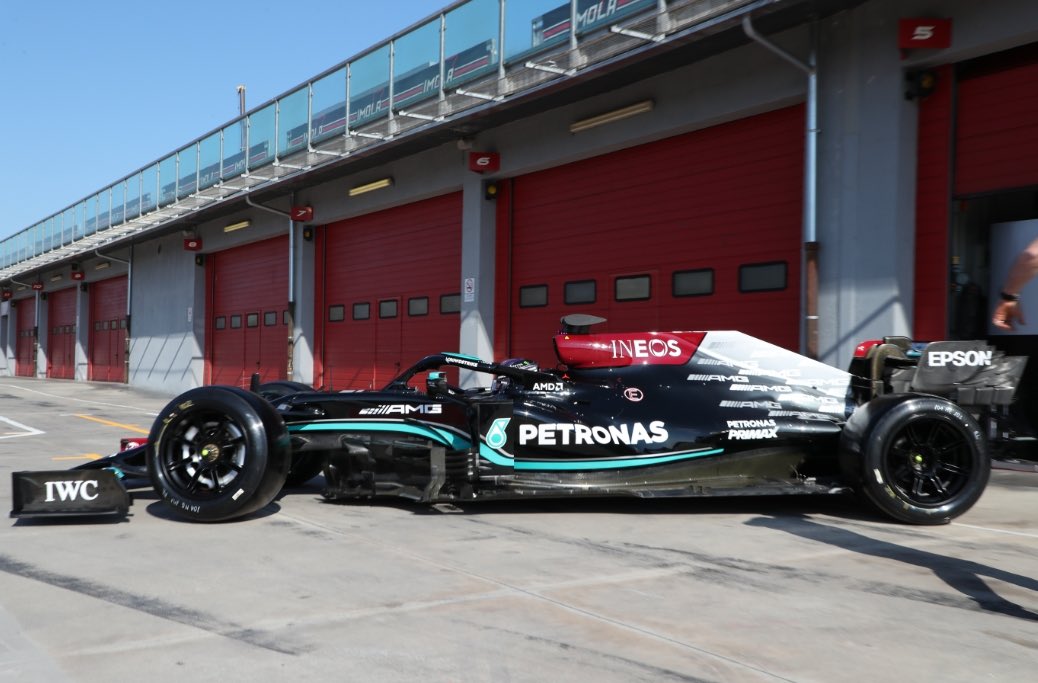
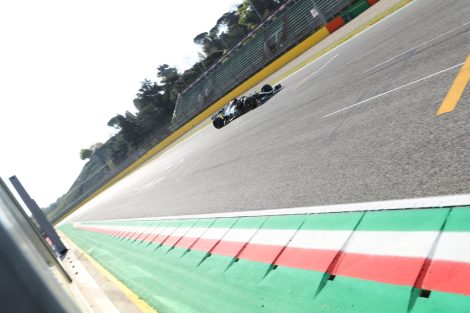
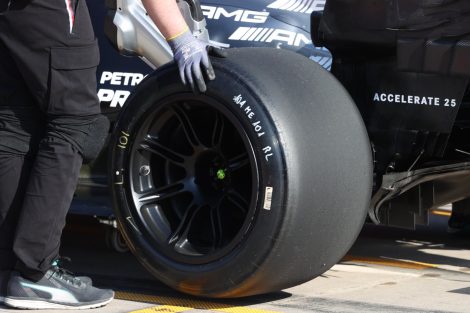
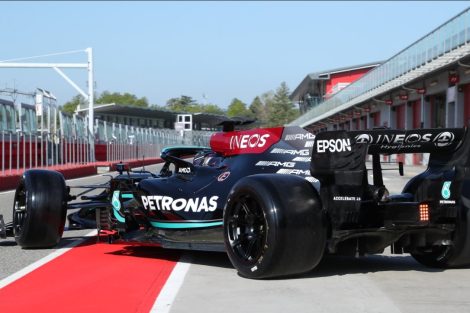
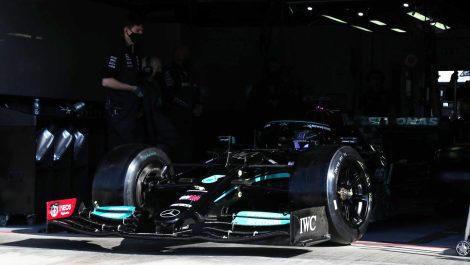
eljueta (@eljueta)
20th April 2021, 10:59
It’s one of those unnecessary upgrades for F1. I guess it’s road relevant?
Jere (@jerejj)
20th April 2021, 11:45
@eljueta Yes, a road-relevant thing.
UNeedAFinn2Win (@uneedafinn2win)
20th April 2021, 12:51
Oh please, how is a tire requiring a highly specific operating temperature window, using a proprietary rubber mix that lasts at most 30-40 minutes and is discarded immediately after use in any way road relevant ?
I mean, sure it makes grocery shopping on 405mm slicks in the Finnish winter interesting…
Jose Torres
20th April 2021, 14:56
https://www.racefans.net/2018/09/03/michelin-13-inch-tyres-2020-f1-return-no-go/
Good question, we should ask Michelin why they proposed the switch to 18″ wheels for so long. and why they said 13″ “has nothing to do with the real world”.
TSmith
20th April 2021, 15:09
By that logic, how is a 13 inch rim with a tire that looks like an inflated balloon road relevant? It’s not. But the tire manufacturers can learn about new forms of tire structure with these 18s that can translate to a road version. They won’t learn these things with 13 inch rims because the structure of a 13 inch tire and 18 inch tire are too different to be comparable.
Sensord4notbeingafanboi (@peartree)
20th April 2021, 19:06
good one. such a silly excuse that everyone falls for. in the ebd of tge day noyhing about racing is relevant to mr or you but the spectacle.
Balue (@balue)
20th April 2021, 20:26
@uneedafinn2win
It’s relevant in the same way as F1 is environmentally friendly because they partly use biofuel while hauling a bunch of cargo jets all over the world.
Roger Ayles (@roger-ayles)
20th April 2021, 12:12
@eljueta @jerejj Road Relevance is the one that keeps been thrown around but they do also apparently offer performance & racing benefits.
I was reading an article a few months ago that really dug into some of the other benefits but I can’t find it now. From memory some of the things listed were around the smaller sidewall’s allowing for a stiffer construction which would take away a lot of the crush of the tyre sidewall which would not only have some aerodynamic benefits but also allow for a more stable platform to optimise the ground effects as well as put a far greater emphasis on the suspension & give teams greater control over ride & ride height (Currently most of the vertical travel comes from the tyre sidewall).
It was also said that the tyres should also allow for closer racing as they will generate more mechanical grip, Suffer less degredation & have better thermal distribution which will allow drivers to push harder for longer.
Other categories have made the move to 18″ tyres already & it’s not done any of them any harm from what I can see so it’s about time F1 caught up. Sticking with the unusually small 13″ tyres just because that’s the way it’s been for ages just makes F1 look behind the times.
Warren2185 (@warren2185)
20th April 2021, 13:06
I think this is the most important aspect and I don’t see it mentioned much. Thanks for bringing it up.
DaveW (@dmw)
20th April 2021, 13:12
Low profile tires are just better for performance (for high powered cars, not your base model Civic), so it has to happen at some point for the pinnacle of motorsport.
If they want to be “road relevant,” no supercar or sports car is on 18s now. Even a sporty FWD sedan is on 19s or 20s now. High end machinery might see 22s. Maybe they should just go to 20s and shrink down those sidewalls for the proper “stance.”
Robbie (@robbie)
20th April 2021, 17:56
@roger-ayles Yeah all that you have said has been my understanding of the new tires too. Too bad we haven’t heard LH’s current assessment of what he just tested, and only his assumptions from a year ago. I sure don’t get why they would be providing less grip i.e. not enough of the mechanical grip LH yearns for, when that can well be designed into the tires via the chemical compounds. Do WEC drivers complain of no mechanical grip on their 18 inchers in their cars that I can only assume don’t provide nearly the downforce that F1 cars do?
anon
20th April 2021, 22:44
@roger-ayles in the case of Michelin, they have said that the biggest driving force for them is aesthetics and advertising potential coming from that, with the technical justifications being more of a secondary concern.
The “road relevance” wasn’t so much about technology transfer as it was about “producing a tyre that shares visual characteristics with a road car tyre” because it would then tie in with their marketing strategy – they want to promote larger diameter and lower profile tyres, and getting F1 to move in that direction would have significantly helped with that strategy.
Now, it is true that there is a trend for tyres with a higher sidewall to have greater compliance, which can be both a positive and negative trait in terms of the impact it has on handling, and the reduced deflection of the tyre sidewall does have some aerodynamic benefits.
However, some of the other items are not necessarily a given – items such as the thermal characteristics or degradation characteristics can be more indirect and relate to the construction of the tyre carcass. In the case of Bridgestone, we saw that they were able to produce 13 inch tyres that had low degradation rates and a wide operating temperature range, so those characteristics are not necessarily inherent to a larger diameter and lower profile tyre.
It is also worth noting that, in some cases, the decision to move to an 18 inch rim may be dictated by other decisions. In the case of the WEC, although it wasn’t explicitly mandated, the rules were written in such a way that you had to use 18 inch rims – basically, by making it that the only way you could fit the largest possible brake discs was if you used 18 inch rims, which did happen to tie in ever so nicely with what Michelin (one of the primary sponsors of the WEC) just happened to want to see at the time. Aerodynamic loads weren’t really what drove that change – it’s been pointed out that earlier Group C sportscars ran slightly smaller rims and higher profile tyres, even when the aerodynamic loads from that era were even higher than in later years.
@robbie with regards to your question about downforce figures – on the contrary, in terms of raw downforce figures, the current Prototype sportscar class is reckoned to be similar, or even outstrip, contemporary F1 cars.
Wurz and Lotterer have both commented in the past that their LMP1 cars produced more downforce than an equivalent F1 car of the time, even if that is based on cars from a few years back, and that more of the differences in performance were due to the lower power and higher weight of a sports prototype car. The back of the envelope calculations that some have undertaken based on cornering speeds and estimates of the tyre properties and weights of the cars would also suggest that contemporary Le Mans Prototypes are certainly fairly similar, if not potentially outstrip F1 cars, in terms of downforce produced.
When you stop to think about it, it actually makes a lot of sense that the Le Mans Prototypes would be capable of producing similar, if not higher, levels of downforce. If you look at, say, just the rear wing dimensions, the prototype car has a rear wing that’s nearly double the width of an F1 car – which not only means they have a larger surface area to work with, the higher span to chord ratio means that rear wing is inherently more efficient than that on an F1 car.
Le Mans Prototype cars have larger rear diffusers, have front bodywork that acts as a combined front wing and front diffuser, whilst the total floor area is similar, if not larger, than that which a Formula 1 car is permitted to use. Furthermore, by enclosing the front wheels, the negative lift that would be produced by the tyres if they were in an exposed airflow is significantly reduced.
It’s not quite 1990s levels, where the Group C sportscars of that era outrstripped the F1 cars of that era by a massive margin – some Group C sportscars could probably outstrip a modern LMP car – but it is still the case that they’re certainly not lacking for downforce and can certainly give a modern F1 car a good run for its money in that department.
Robbie (@robbie)
21st April 2021, 14:48
anon Thank you re the WEC downforce levels. I had made an assumption and you have well informed me.
Robbie (@robbie)
21st April 2021, 15:05
anon Found this article from 3 years ago almost to the day of Hartley comparing the two types of cars. Speaks about tires, and of F1 having higher downforce but particularly because of higher top speeds and higher speed corners. Doesn’t negate what you have said because for sure I think it safe to say the higher the speed the more effective a wing or body panel can be at producing downforce…see airplanes that need speed to take off, and how little wing a light fighter jet that is much faster than a heavy passenger plane with it’s huge wings needs to do so.
https://www.racefans.net/2018/04/23/hartley-biggest-difference-between-f1-and-lmp1-isnt-the-cars/
Coventry Climax
21st April 2021, 12:26
It’s not unneccesary at all. You just have to look at the slo-mo’s in corners, where the tyres wobble, flop and oscillate about the rims. Travel, stiffness and strength of suspension, springs and shock absorbers can be engineered and adjusted according to need, the incontrollable behaviour of these silly balloon tyres can’t.
So the gain is engineered control over carbehaviour in corners. That is relevant to whatever type of car, but certainly relevant to the top-notch technical sport that F1 is (was?) supposed to bem, and certainly relevant in the light of the aero-problems (cars unable to follow one another closely) that we face these last years. It’s not the sole, simple solution to these problems, but certainly part of it. The flipside of the coin is the increaded rotational inertia of a bigger rim (making it to try to slower respond to changes in rotational speed, meaning braking and accelerating, as well as changes in direction) but it is generally believed that the plusses outweigh these minusses.
For once and for all: there’s tyres and rims. It’s not the outside diameter of the tyre that changes to 18″, it’s the outside diameter of the rim that changes. Correspondingly, the height of the tyre wall will decrease, which will make the sides stiffer and less unpredictable.
Vegggen (@vegggen)
20th April 2021, 11:05
They do not look particularly low profile though.
Most sport road cars have larger rims and less sidewall than that nowadays.
Not convinced by the road relevance argument anyways.
BasCB (@bascb)
20th April 2021, 11:52
Both Pirelli and Michelin have stated that they are reluctant to further work on development of tyres for 13″ rims since it is completely irrelevant for any other tyres they make apart from F1 @vegggen.
In contrast, the 18″ rims brings their experience close enough to road tyres and other performance tyres that there is a crossover of know-how between them, eliminating part of the need for seperate research just for F1 and meaning that some things from F1 can be carried over to their other tyres.
Erzen (@xenn1)
20th April 2021, 11:54
I think it’s the way to go with the size of the cars also increasing. The road relevance is also a factor but maybe not as much as they tout it to be.
The rolling diameter of the car stays the same, your comment on the profile of the tire just highlights how high the tire/wheel ratio is right now. With the lower profile the aero will also be less disturbed because the tires will be moving around a lot less and the tire temps will be easier to manage and help them keep the performance more consistent throughout a longer stint. I think on that alone it’s a step in the right direction
Rodber
20th April 2021, 11:09
Reminds me of a certain, illegal, three day tyre test that was carried out [in 2016?] using current car and drivers, after which Mercedes gained rapid and utter domination over F1. Add best engine and chassis for good measure and you have our current predicament.
Kim Philby (@philby)
20th April 2021, 11:12
@Rodber It was 2013 but otherwise, spot on.
Rodber
20th April 2021, 11:20
Of course, thanks @Kim Philby, my bad
must be my hangover
2016 was when a totally pedestrian driver made champ, beating Lewis with ease…
anon
20th April 2021, 22:48
@philby mind you, it was pointed out that the technical changes that Pirelli introduced for the late season 2013 tyres that were used in that test were actually detrimental to Mercedes’s performance, whilst largely favouring Sauber and Red Bull – they both saw a significant performance boost with the new tyres that was directly linked to the change in tyre wall construction and the impacts it had on the deformability of the tyre carcass.
John H (@john-h)
20th April 2021, 11:29
Rodber, you seem to have forgotten Ferrari’s illegal engine that meant that Mercedes didn’t actually dominate F1. Funny that. As regards your reply to Kim Philby, it’s just sad. No more to add.
Sensord4notbeingafanboi (@peartree)
20th April 2021, 19:07
mercedes has not dominated f1
Balue (@balue)
20th April 2021, 20:35
Yeah that’s one for the books lol
Erzen (@xenn1)
20th April 2021, 11:55
You’re saying this as if Mercedes is the only team getting the privilege of testing the tires.
Iorwerth
20th April 2021, 11:58
So tell me how is this test illegal, Ferrari and Alpine have already tested them, all the others bar Williams are due to test them during the season, but I suppose facts are not your friend when you feel the need to have a dig at Mercedes!
DeanR
20th April 2021, 16:29
And will very little useful data to done from it for this season. Let Rodber have his fun though…bless him.
Balue (@balue)
20th April 2021, 20:35
@Rodber
Indeed, although I believe all teams are supposed to have equal time on it. This is anyway a good time for some extra laps though 2 races in, with niggly aero to learn more about.
Fredrik von Werder (@freguz)
20th April 2021, 11:13
Not quite F1 anymore :-(
Jose Torres
20th April 2021, 15:10
Yes, since F1 no longer uses the same tyre that the Auto Union Type C thing are not the same.
Adrian Hancox (@ahxshades)
20th April 2021, 16:47
Indeed, never been the same since they put the engines at the back, and dont get me started on those silly helmet things they wear :)
sumedh
20th April 2021, 11:33
I am sure he came on the radio right after Tamburello on his out lap saying “These tyres are gone, Bono”.
And then proceeded to set the lap record :)
ian dearing
20th April 2021, 11:53
I doubt whether there is any other team; or many within Mercedes, who have any idea what those messages between Bono and Ham actually mean.
Jere (@jerejj)
20th April 2021, 11:48
A modified W10? Regardless, I still find Pirelli sharing entire car images, as they did with Alpine in Bahrain, weird because they didn’t do so when Ferrari conducted 18-inch tests.
What’s the difference?
HAL
20th April 2021, 11:51
Give the contract to Michelin and the time lost will transform in gain ! More seriously, I for one look forward to the change. The old 13 inches rim seems outdated and I’m pretty sure it won’t take long before the potential grop loss will be recovered.
Patrick (@paeschli)
20th April 2021, 13:17
That’s the only thing I’m looking forward to with the change to 18 inch rims: Michelin coming back
Wayne
20th April 2021, 12:11
2013 tyre test eas not illegal nor secret. It was just private. Its coincidental that the mercs became ultra competitive.
James Martin
20th April 2021, 13:15
It was illegal. In season testing on the current cars is banned.
Tim Lemmens
20th April 2021, 19:42
It was illegal:
“Mercedes has been found guilty of breaking the rules in F1 by using a 2013 car during tests for Pirelli earlier this year.”
And they were punished, all be it minor:
” it will not be allowed to take part in next month’s three-day young driver test at Silverstone.”
George
20th April 2021, 15:28
Ugly. It’s just another change to bring more American viewers with this pimp my ride style ferris wheel.
Ole Brummer (@andrewwj)
20th April 2021, 15:44
If it ain’t broke, fix it!
dutchtreat (@dutchtreat)
20th April 2021, 19:25
It looks to me that you can’t ride over curbs very aggressively with 18 inch since you may brake the suspension due to less give in the tyre. If you compensate with a softer set up, the car will not handle as well. Curious to see how it pans out.
Qeki (@qeki)
20th April 2021, 19:34
I actually think 18 inch looks quite good.
Matt
20th April 2021, 20:45
I’m looking forward to racing-relevant tires. I’m also looking forward to less influence of sidewall and sidewall temperature and air pressure in F1 handelling. Having an 18″ rim to collapse on should also allow for the occasional hail mary tire strategy.
IVAYLO
20th April 2021, 22:45
Personally I think it looks ugly. I cannot comment on “road relevancy”.
My hope is that this attract more manufacturers into Formula One, which could persuade those in charge to drop the exclusivity deal with Pirelli. I’d quickly forget about the aesthetic then.
Milton (@stevemilton)
21st April 2021, 0:57
13”. When you’ve been around F1 for as long as I have, then you would know the 13” rim rule was there solely to control the size of breaks. Imagine if you had 20” rims, how large the breaks could be and consequently how affordable they would be to have the same breaking power compared to today’s smaller breaks. Back in the ‘70s we went towards inboard breaks to counteract this rule which was quickly banned and stated the breaks had to be in the inside the wheel rims.
Wayne
21st April 2021, 5:13
You guys are right 2013 tyre test was deeemed illegal. My apologies for my incorrect statement. I retract it in everyway. But thats not the sole reason as to why they became ultra competitive.
Mr_NovemberHotel (@nicharvs)
21st April 2021, 7:06
Ok let’s get this sorted. The greater the tyre wall the greater the grip the tyre can provide. The grip of the tyre is dependent on the softness of the compound (its ability to mould around and grip into the tarmac) and the flexibility and elasticity of the tyre wall (transfers the grip provided by the compound to the wheel rim). Bigger rims provide more space to fit larger brakes. That’s pretty much it, they do not increase grip. Larger rims on an f1 car will decrease braking zones (cars breaking later) and increase tyre wear (more reliance on the compound for grip).
From an engineering standpoint, for a fixed wheel size, you would find the best ratio between tyre wall size and rim size that would give you the best lap time.
If you want to argue the point, modern road cars have bigger and bigger rims, mainly because weights are getting higher and higher, so they need more stopping power, added to that tyre technology can make up the grip from the compound rather than the tyre wall. Go have a look at the tyre walls on go carts, they provide phenomenal grip, and the tyre wall is almost half the radius of the tyre. Or if that doesn’t prove the point look at a dragsters rear tyre’s required to put thousands of horse power to the road, the tyre wall is massive.
Coventry Climax
21st April 2021, 16:13
What exactly is your field of expertise, @NicHarvs? I very much doubt it is in the automotive sector.
Your “OK, let’s get this sorted” sounds authoritative, but what follows, is of the sort you’ld rather not step into.
Mr_NovemberHotel (@nicharvs)
21st April 2021, 22:37
I’m an aeronautics engineer and airline pilot. You will find a lot of technologies used on aircraft are very similar to that on aircraft. Tyre technology and theory does not differ significantly from aircraft and road cars.
Coventry Climax
22nd April 2021, 11:48
I’m an automotive engineer. To my opinion, the required characteristics for automotive tyres differ hugely from those for aircraft. For example in aircraft, I doubt there is a requirement for highspeed cornering, a need for sudden changes in direction etc, while in the automotive environment, the tyre is not designed for touch-downs, with the carcass and compounds to guarantee integrity and safety over a long period of time.
I’d say it’s like comparing the tyres needed for tractors to those needed for bicycles. (Even within the bicycle-industry there’s quite a difference.) Yes, they have things in common, yet are worlds apart.
Stash (@stash)
21st April 2021, 8:04
These new wheels will have their dash and then crash. Low profile is not F1. Never has been. Ever. Road relevance? I have heard it all. If you say it enough times then there are those that will believe. Reminds me of an Indy car. Master class in how to lose your identity F1.
ian dearing
21st April 2021, 11:03
https://twitter.com/JustNabz/status/1384803172972105729/photo/1
Coventry Climax
21st April 2021, 12:08
Shocking, @Keith Collantine, that the title says ’18” TYRES’. There’s no such thing involved here and you know it. There’s so much nonsense written and commented about it, with people not knowing the difference between a rim and a tyre and which diameter it is exactly that goes from 13 to 18 inch, that I had hoped at least you would have gotten the definitions right, but alas, this just adds to the confusion and ignorance of your audience. You’ve done so much better before.